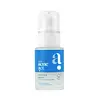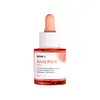What's inside
What's inside
 Key Ingredients
Key Ingredients

 Benefits
Benefits

 Concerns
Concerns

 Ingredients Side-by-side
Ingredients Side-by-side

Water
Skin ConditioningNiacinamide
SmoothingPropanediol
SolventMethyl Gluceth-20
HumectantZinc Gluconate
Skin ConditioningSalicylic Acid
MaskingDimethicone
EmollientPhenoxyethanol
PreservativeCetearyl Alcohol
EmollientSodium Hydroxide
BufferingSteareth-21
CleansingDicaprylyl Carbonate
EmollientHydroxyethyl Acrylate/Sodium Acryloyldimethyl Taurate Copolymer
Emulsion StabilisingXanthan Gum
EmulsifyingPCA
HumectantMyristyl Alcohol
EmollientButylene Glycol
HumectantCeteareth-33
CleansingSodium Metabisulfite
AntioxidantEthylhexylglycerin
Skin ConditioningAllantoin
Skin ConditioningMadecassoside
AntioxidantCentella Asiatica Extract
CleansingSorbitan Isostearate
EmulsifyingPolysorbate 60
EmulsifyingPolygonum Cuspidatum Root Extract
AntioxidantScutellaria Baicalensis Root Extract
AstringentDisodium EDTA
Glycyrrhiza Glabra Root Extract
BleachingCamellia Sinensis Leaf Extract
AntimicrobialRosmarinus Officinalis Leaf Extract
AntimicrobialChamomilla Recutita Flower Extract
MaskingWater, Niacinamide, Propanediol, Methyl Gluceth-20, Zinc Gluconate, Salicylic Acid, Dimethicone, Phenoxyethanol, Cetearyl Alcohol, Sodium Hydroxide, Steareth-21, Dicaprylyl Carbonate, Hydroxyethyl Acrylate/Sodium Acryloyldimethyl Taurate Copolymer, Xanthan Gum, PCA, Myristyl Alcohol, Butylene Glycol, Ceteareth-33, Sodium Metabisulfite, Ethylhexylglycerin, Allantoin, Madecassoside, Centella Asiatica Extract, Sorbitan Isostearate, Polysorbate 60, Polygonum Cuspidatum Root Extract, Scutellaria Baicalensis Root Extract, Disodium EDTA, Glycyrrhiza Glabra Root Extract, Camellia Sinensis Leaf Extract, Rosmarinus Officinalis Leaf Extract, Chamomilla Recutita Flower Extract
Water
Skin ConditioningCentella Asiatica Leaf Extract
Skin ConditioningNiacinamide
SmoothingCyclopentasiloxane
EmollientDiglycerin
HumectantButylene Glycol
HumectantDimethicone
EmollientPolyglycerin-6
HumectantPEG-8
HumectantAllantoin
Skin ConditioningTocopheryl Acetate
AntioxidantPhenoxyethanol
PreservativeAmmonium Polyacryloyldimethyl Taurate
Emulsion StabilisingHydrolyzed Corn Starch
HumectantPolyacrylamide
Beta Vulgaris Root Extract
Skin ConditioningBakuchiol
AntimicrobialSalicylic Acid
MaskingAminomethyl Propanol
BufferingC13-14 Isoparaffin
EmollientDipotassium Glycyrrhizate
HumectantMethylpropanediol
SolventChlorphenesin
AntimicrobialPropanediol
SolventLauric Acid
CleansingDisodium EDTA
1,2-Hexanediol
Skin ConditioningLactic Acid
BufferingLaureth-7
EmulsifyingLauryl Alcohol Diphosphonic Acid
Emulsion StabilisingIsostearamidopropyl Ethyldimonium Ethosulfate
Sodium Hydroxide
BufferingHylocereus Undatus Fruit Extract
Skin ConditioningScutellaria Baicalensis Root Extract
AstringentBeta Vulgaris Extract
Skin ProtectingCamellia Sinensis Leaf Extract
AntimicrobialGlycyrrhiza Glabra Root Extract
BleachingRosmarinus Officinalis Leaf Extract
AntimicrobialEthylhexylglycerin
Skin ConditioningSodium Benzoate
MaskingCyclotetrasiloxane
EmollientBoswellia Serrata Extract
Skin ConditioningHoney Extract
HumectantOryza Sativa Extract
AbsorbentGlycerin
HumectantPropylene Glycol
HumectantP-Anisic Acid
MaskingOligopeptide-10
Antimicrobial2-Aminobutanol
BufferingCarthamus Tinctorius Seed Oil
MaskingOlea Europaea Fruit Oil
MaskingBromelain
Skin ConditioningPapain
Skin ConditioningWater, Centella Asiatica Leaf Extract, Niacinamide, Cyclopentasiloxane, Diglycerin, Butylene Glycol, Dimethicone, Polyglycerin-6, PEG-8, Allantoin, Tocopheryl Acetate, Phenoxyethanol, Ammonium Polyacryloyldimethyl Taurate, Hydrolyzed Corn Starch, Polyacrylamide, Beta Vulgaris Root Extract, Bakuchiol, Salicylic Acid, Aminomethyl Propanol, C13-14 Isoparaffin, Dipotassium Glycyrrhizate, Methylpropanediol, Chlorphenesin, Propanediol, Lauric Acid, Disodium EDTA, 1,2-Hexanediol, Lactic Acid, Laureth-7, Lauryl Alcohol Diphosphonic Acid, Isostearamidopropyl Ethyldimonium Ethosulfate, Sodium Hydroxide, Hylocereus Undatus Fruit Extract, Scutellaria Baicalensis Root Extract, Beta Vulgaris Extract, Camellia Sinensis Leaf Extract, Glycyrrhiza Glabra Root Extract, Rosmarinus Officinalis Leaf Extract, Ethylhexylglycerin, Sodium Benzoate, Cyclotetrasiloxane, Boswellia Serrata Extract, Honey Extract, Oryza Sativa Extract, Glycerin, Propylene Glycol, P-Anisic Acid, Oligopeptide-10, 2-Aminobutanol, Carthamus Tinctorius Seed Oil, Olea Europaea Fruit Oil, Bromelain, Papain
Ingredients Explained
These ingredients are found in both products.
Ingredients higher up in an ingredient list are typically present in a larger amount.
Allantoin is a soothing ingredient known for its protective and moisturizingg properties. Because of this, it is often added to products with strong active ingredients.
Studies show higher concentrations of this ingredient can promote wound healing.
Though it can be derived from the comfrey plant, allantoin is produced synthetically for cosmetic products to ensure purity.
Learn more about AllantoinButylene Glycol (or BG) is used within cosmetic products for a few different reasons:
Overall, Butylene Glycol is a safe and well-rounded ingredient that works well with other ingredients.
Though this ingredient works well with most skin types, some people with sensitive skin may experience a reaction such as allergic rashes, closed comedones, or itchiness.
Learn more about Butylene GlycolCamellia Sinensis Leaf Extract is derived from the leaves of the tea plant. Black tea, green tea, and oolong tea are all harvested from this plant.
This ingredient has many skin benefits:
This ingredient contains polyphenols, a strong antioxidant. Antioxidants help fight off molecules that damage skin cells.
On top of that, the antioxidants in green tea neutralize free-radicals from the sun. This gives the skin some extra UV protection, but should not replace sunscreen.
Many components of tea have anti-inflammatory properties.
Polyphenols and L-theanine help soothe the skin and reduce irritation. The caffeine in Camellia Sinensis Leaf Extract helps calm inflamed blood vessels.
Other compounds found in tea include: Vitamin Bs, linoleic acid, magnesium, calcium, iron, and zinc.
Research has shown both drinking Camellia Sinensis Leaf Tea and applying it to the skin can help boost skin elasticity and hydration. Studies also show using tea extract may reduce sebum, or oil, production.
Learn more about Camellia Sinensis Leaf ExtractDimethicone is a type of synthetic silicone created from natural materials such as quartz.
What it does:
Dimethicone comes in different viscosities:
Depending on the viscosity, dimethicone has different properties.
Ingredients lists don't always show which type is used, so we recommend reaching out to the brand if you have questions about the viscosity.
This ingredient is unlikely to cause irritation because it does not get absorbed into skin. However, people with silicone allergies should be careful about using this ingredient.
Note: Dimethicone may contribute to pilling. This is because it is not oil or water soluble, so pilling may occur when layered with products. When mixed with heavy oils in a formula, the outcome is also quite greasy.
Learn more about DimethiconeDisodium EDTA plays a role in making products more stable by aiding other preservatives.
It is a chelating agent, meaning it neutralizes metal ions that may be found in a product.
Disodium EDTA is a salt of edetic acid and is found to be safe in cosmetic ingredients.
Learn more about Disodium EDTAEthylhexylglycerin (we can't pronounce this either) is commonly used as a preservative and skin softener. It is derived from glyceryl.
You might see Ethylhexylglycerin often paired with other preservatives such as phenoxyethanol. Ethylhexylglycerin has been found to increase the effectiveness of these other preservatives.
Glycyrrhiza Glabra Root Extract is an extract of the roots of Licorice. It has been found to have several benefits such as skin hydrating, conditioning, and soothing.
One component, glabridin, has extra potent antioxidant and soothing properties. It has also been found to block pigmentation from UVB rays in guinea pigs.
Licorice Root also contains a flavonoid. Flavonoids are a natural substance from in plants. Flavonoids also have antioxidant properties.
Another component, glycyrrhizin, has been found to have anti-inflammatory and antimicrobial benefits. This may make licorice root extract effective at treating acne. However, more research is needed to support this.
Liquiritin is one of the flavone compounds found in licorice. It has been found to help lighten skin by preventing tyrosinase from reacting with tyrosine. When the two react, protein is converted to melanin. Melanin is the substance in your body that gives your features pigmentation.
Learn more about Glycyrrhiza Glabra Root ExtractNiacinamide is a multitasking form of vitamin B3 that strengthens the skin barrier, reduces pores and dark spots, regulates oil, and improves signs of aging.
And the best part? It's gentle and well-tolerated by most skin types, including sensitive and reactive skin.
You might have heard of "niacin flush", or the reddening of skin that causes itchiness. Niacinamide has not been found to cause this.
In very rare cases, some individuals may not be able to tolerate niacinamide at all or experience an allergic reaction to it.
If you are experiencing flaking, irritation, and dryness with this ingredient, be sure to double check all your products as this ingredient can be found in all categories of skincare.
When incorporating niacinamide into your routine, look out for concentration amounts. Typically, 5% niacinamide provides benefits such as fading dark spots. However, if you have sensitive skin, it is better to begin with a smaller concentration.
When you apply niacinamide to your skin, your body converts it into nicotinamide adenine dinucleotide (NAD). NAD is an essential coenzyme that is already found in your cells as "fuel" and powers countless biological processes.
In your skin, NAD helps repair cell damage, produce new healthy cells, support collagen production, strengthen the skin barrier, and fight environmental stressors (like UV and pollution).
Our natural NAD levels start to decline with age, leading to slower skin repair, visible aging, and a weaker skin barrier. By providing your skin niacinamide, you're recharging your skin's NAD levels. This leads to stronger, healthier, and younger looking skin.
Another name for vitamin B3 is nicotinamide. This vitamin is water-soluble and our bodies don't store it. We obtain Vitamin B3 from either food or skincare. Meat, fish, wheat, yeast, and leafy greens contain vitamin B3.
The type of niacinamide used in skincare is synthetically created.
Learn more about NiacinamidePhenoxyethanol is a preservative that has germicide, antimicrobial, and aromatic properties. Studies show that phenoxyethanol can prevent microbial growth. By itself, it has a scent that is similar to that of a rose.
It's often used in formulations along with Caprylyl Glycol to preserve the shelf life of products.
Propanediol is an all-star ingredient. It softens, hydrates, and smooths the skin.
It’s often used to:
Propanediol is not likely to cause sensitivity and considered safe to use. It is derived from corn or petroleum with a clear color and no scent.
Learn more about PropanediolRosmarinus Officinalis Leaf Extract comes from rosemary. Rosemary is native to the Mediterranean.
While Rosmarinus Officinalis Leaf Oil can be volatile due to its fragrant properties, the fragrance components are usually removed in the leaf extract.
Rosemary Leaf Extract contains many antioxidants such as rosmarinic acid and caffeic acid. Rosemarinic acid, a compound found in rosemary leaf, has been found to help soothe skin conditions such as eczema and acne.
Learn more about Rosmarinus Officinalis Leaf ExtractSalicylic Acid (also known as beta hydroxy acid or BHA) is a well-known ingredient for treating skin that struggles with acne and clogged pores. It exfoliates both the skin's surface and deep within the pores to help clear out buildup, control oil, and reduce inflammation.
Unlike AHAs (alpha hydroxy acids), salicylic acid is oil-soluble. This allows it to penetrate into pores which makes it especially effective for treating blackheads and preventing future breakouts.
Salicylic acid is also known for its soothing properties. It has a similar structure to aspirin and can calm inflamed or irritated skin, making it a good option for acne-prone skin that is also sensitive.
Concentrations of 0.5-2% are recognized by the U.S. FDA as an over-the-counter topical acne product.
It can cause irritation and/or dryness if one's skin already has a compromised moisture barrier, so it's best to focus on repairing that before introducing this ingredient into your routine.
While salicylic acid does not increase sun sensitivity, it’s still important to wear sunscreen daily to protect your skin.
If you are looking for the ingredient called BHA or Butylated Hydroxyanisole, click here.
Learn more about Salicylic AcidScutellaria Baicalensis Root Extract comes from the Baikal skullcap or Chinese skullcap plant. This plant is native to Northeast Asia and can be found in China, Mongolia, Korea, and Siberia.
In cosmetics, Scutellaria Baicalensis Root Extract provides antioxidant and anti-inflammatory benefits. This is due to the flavonoid composition of Scutellaria Baicalensis Root Extract.
In Chinese traditional folk medicine, Scutellaria Baicalensis Root Extract is used to help treat lung issues and hypertension.
Learn more about Scutellaria Baicalensis Root ExtractSodium Hydroxide is also known as lye or caustic soda. It is used to adjust the pH of products; many ingredients require a specific pH to be effective.
In small amounts, sodium hydroxide is considered safe to use. However, large amounts may cause chemical burns due to its high alkaline.
Your skin has a natural pH and acid mantle. This acid mantle helps prevent harmful bacteria from breaking through. The acid mantle also helps keep your skin hydrated.
"Alkaline" refers to a high pH level. A low pH level would be considered acidic.
Learn more about Sodium HydroxideWater. It's the most common cosmetic ingredient of all. You'll usually see it at the top of ingredient lists, meaning that it makes up the largest part of the product.
So why is it so popular? Water most often acts as a solvent - this means that it helps dissolve other ingredients into the formulation.
You'll also recognize water as that liquid we all need to stay alive. If you see this, drink a glass of water. Stay hydrated!
Learn more about Water